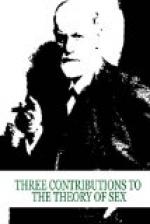[25] The well-known fancies of perverts which under favorable conditions are changed into contrivances, the delusional fears of paranoiacs which are in a hostile manner projected on others, and the unconscious fancies of hysterics which are discovered in their symptoms by psychoanalysis, agree as to content in the minutest details.
[26] A psychoneurosis very often associates itself with a manifest inversion in which the heterosexual feeling becomes subjected to complete repression.—It is but just to state that the necessity of a general recognition of the tendency to inversion in psychoneurotics was first imparted to me personally by Wilh. Fliess, of Berlin, after I had myself discovered it in some cases.
[27] It is not easy to justify here this assumption which was taken from a definite class of neurotic diseases. On the other hand, it would be impossible to assert anything definite concerning the impulses if one did not take the trouble of mentioning these presuppositions.
[28] One should here think of Moll’s assertion, who divides the sexual impulse into the impulses of contrectation and detumescence. Contrectation signifies a desire to touch the skin.
II
THE INFANTILE SEXUALITY
It is a part of popular belief about the sexual impulse that it is absent in childhood and that it first appears in the period of life known as puberty. This, though a common error, is serious in its consequences and is chiefly due to our present ignorance of the fundamental principles of the sexual life. A comprehensive study of the sexual manifestations of childhood would probably reveal to us the existence of the essential features of the sexual impulse, and would make us acquainted with its development and its composition from various sources.
The Neglect of the Infantile.—It is remarkable that those writers who endeavor to explain the qualities and reactions of the adult individual have given so much more attention to the ancestral period than to the period of the individual’s own existence—that is, they have attributed more influence to heredity than to childhood. As a matter of fact, it might well be supposed that the influence of the latter period would be easier to understand, and that it would be entitled to more consideration than heredity.[1] To be sure, one occasionally finds in medical literature notes on the premature sexual activities of small children, about erections and masturbation and even actions resembling coitus, but these are referred to merely as exceptional occurrences, as curiosities, or as deterring examples of premature perversity. No author has to my knowledge recognized the normality of the sexual impulse in childhood, and in the numerous writings on the development of the child the chapter on “Sexual Development” is usually passed over.[2]




